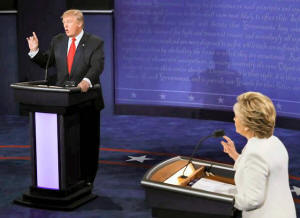|
Must see TV: why gutting NAFTA unlikely
to create U.S. jobs
 Send a link to a friend
Send a link to a friend
 [October 25, 2016]
By Timothy Aeppel [October 25, 2016]
By Timothy Aeppel
CUIDAD JUAREZ, MEXICO (Reuters) - Both U.S.
presidential candidates routinely criticize free-trade deals they blame
for the loss of American jobs.
But tweaking the North American Free Trade Agreement (NAFTA), as Hillary
Clinton has pledged to do, or ripping it up, as Donald Trump demands,
may do nothing to help companies like Element Electronics Corp, which
owns America’s last television factory.
Winnsboro, South Carolina-based Element, and the television industry
more broadly, offer a window into the complexity of industrial supply
chains and illustrate why pushing manufacturing jobs back to the United
States is so difficult.
Element's plant in South Carolina is nearly identical to a rival factory
operated by Taiwanese conglomerate Tatung Company that sits on a dusty
back street in this Mexican border town. Both import nearly all their
components from Asia. The parts often flow in through the same southern
California ports.
But there's a big, and costly, difference. The Mexican plant, by sitting
just over the border from El Paso, Texas, doesn't have to pay duty on
those parts, even when the finished televisions are sold in the United
States. But Element's factory has to foot the tariff bill, which makes
its televisions more expensive.
"It's pretty crazy that I'm disadvantaged for using U.S. labor," says
Michael O'Shaughnessy, Element’s president.
That's a sentiment that Trump, the Republican nominee, has forcefully
tapped as he makes the case that radically revamping the trade deal
would level the playing field and bring jobs back. Many trade experts,
though, say it would be a costly disaster to try to unravel these
production networks, which essentially treat Mexico as a 51st state.

The Peterson Institute for International Economics, a Washington think
tank that favors free trade, released a study last month that predicted
imposing stiff tariffs on Mexico and China would disrupt North American
producers that have created global supply chains and push the United
States into a recession.
"The TV industry is characterized by particularly dense webs of
cross-border supply chains with Mexico and China," says Marcus Noland,
the economist who directed the study. "There'd be chaos and a trade
war."
Even many who oppose NAFTA acknowledge it would be disruptive to
suddenly erect barriers, given the way companies have shifted supply
chains to integrate Mexico.
NAFTA'S LEGACY
NAFTA, implemented in 1994, forged a common market between the United
States, Mexico and Canada. In response, many industries, including
television manufactures, have transformed themselves by creating supply
chains that crisscross the border.
Televisions once were produced in the United States and elsewhere with
hundreds of parts, often tucked into elaborate wooden cases. A modern
flat screen, by contrast, has relatively few parts, and more than 70
percent of its value is packed into the glass and the electronics
integrated directly into the panel.
The heart of the industry, including that core glass technology and
production, is now based in Asia.
About half of all TVs imported to the U.S. come from Mexico, says Paul
Gagnon, an expert on the industry's supply chain at IHS Markit, an
economic research firm.
"The main reason for that is so the producers can respond quickly to
fluctuations in demand," he says. TV sales are highly seasonal, spiking
late in the year. In Mexico, some of the factories double their
workforce for just a few months to respond to this.

Gagnon doubts the jobs would come back to the United States, because
margins on TVs are so low. "If there were any major cost increase (in
Mexico), you'd probably see some shift to Asia for production -- rather
than seeing that production happen in the U.S."
Some Mexican plants mold the plastic casing and do other tasks in the
assembly process. But in many cases -- including at both the Element and
Tatung plants -- the assembly plants do mostly finishing touches like
inserting printing circuit boards and tuning the units. This creates
relatively few jobs compared to the kind of television manufacturing
done in the U.S. industry's heyday.
In the 1950s, there were some 150 domestic television manufacturers in
the United States, and employment peaked at about 100,000 in the 1960s.
[to top of second column] |

Republican U.S. presidential nominee Donald Trump speaks as
Democratic U.S. presidential nominee Hillary Clinton listens during
their third and final 2016 presidential campaign debate at UNLV in
Las Vegas, Nevada, U.S., October 19, 2016. REUTERS/Mark Ralston/Pool

Mexico's cost advantage over the United State is formidable.
O’Shaughnessy said he pays his 200 workers, who operate in a
converted shirt factory, about $15 an hour. The pay at the Juarez
plant is about $2.50 an hour.
Even with this edge, it's getting harder to do the work in Mexico,
said Chan-hsing Diao, manager of the Tatung plant. (Tatung doesn't
sell televisions under its own name, but rather is paid by other
manufacturers to assemble their name-brand products.)
"The industry is consolidating and the cost pressures are enormous,"
he said, noting that over the last six years, the amount he is paid
to assemble a 32-inch television has fallen by half, from about $6 a
unit to $3 a unit.
"The profits are this," he said, holding up two fingers almost
touching.
The Tatung plant in Juarez occupies a cavernous space that was once
a windshield factory. It now features long assembly lines for
televisions and produced 15 million TVs over the last seven years,
Diao said. Some 13 million of those were sold in the United States.
In January, the company lost its main customer, a Chinese TV
manufacturer that Diao declined to identify. Tatung is scrambling to
find a new manufacturer that wants to build TVs for the United
States. In the meantime, it continues assembling TVs for Mexico and
some other Latin American markets.
Diao warned there would be a trade war if a new U.S. administration
tore up the NAFTA agreement. With profits already so tight in
Mexico, many Chinese producers might find it easier to ship finished
goods directly from Asia rather than move production and jobs to the
United States, he said.
IN SEARCH OF AN EXEMPTION
O'Shaughnessy, for his part, said he just wants to get the same
break on import duties as Mexico gets under NAFTA. His decision to
build in the United States, he said, was driven entirely by his only
customer for the U.S. plant, Wal-Mart, which uses Element as a
centerpiece of its campaign to promote domestic manufacturing. The
South Carolina TVs are shipped in boxes emblazoned with American
flags and bearing the words "Assembled in the USA."

O'Shaughnessy has appealed for a tariff exemption from his local
congressman, Rep. Mick Mulvaney, a Republican. Mulvaney said he is
sympathetic but has been unable to win over many fellow lawmakers
who consider special exemptions a form of earmarks for special
interests, which many oppose on principle.
"Element makes clear the real world implications of these trade
deals we have signed," said Mulvaney, adding that it's time to
"review" NAFTA to iron out this and other loopholes.
Back in Juarez, the annual ramp-up of hiring is under way at the
Tatung plant to supply the surge of televisions bought over the
holidays. Employment at Tatung goes as low as 280 each year, for
instance, but is now on its way up to 600, Diao said.
"You could never do that in America — at least not easily," he says,
referring to this cycle of hiring and firing large numbers.
(Editing by Eric Effron and Edward Tobin)
[© 2016 Thomson Reuters. All rights
reserved.]
Copyright 2016 Reuters. All rights reserved. This material may not be published,
broadcast, rewritten or redistributed.
 |